Last Chance to Catch NYC's Holiday Notalgia Train
We met the voices of the NYC subway on our nostalgia ride this weekend!


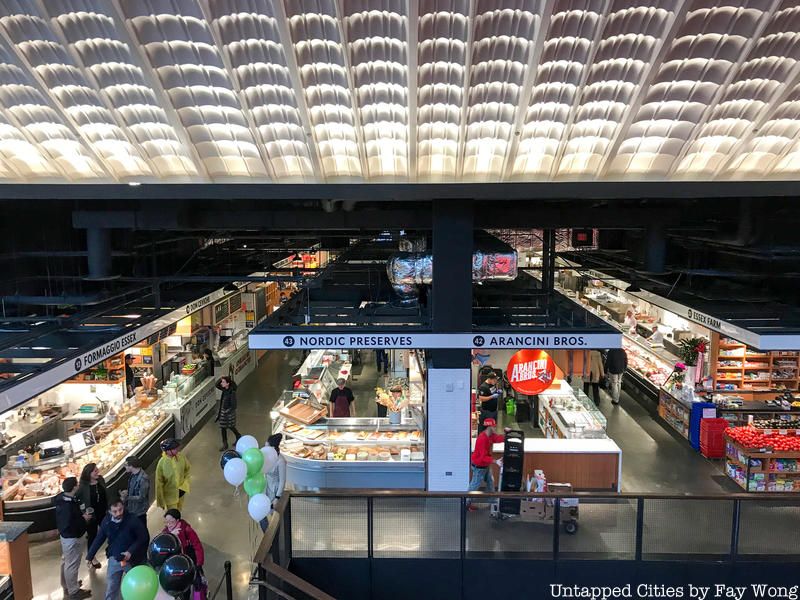
Photo by Fay Wong
Last weekend, after nearly eighty years in operation, the Lower East Side’s Essex Street Market closed it doors. However, the closure was short lived as the market reopened today following a press opening in a brand new space just across the street. The brand new marketplace at 115 Delancey Street is the cornerstone of Essex Crossing, a nine-site, 1.9 million square-foot redevelopment project. Operated as before by the New York City Economic Development Corporation, the new Essex Street Market seeks to continue the traditions of valuing small business and serving as a resource for the community. The new space is larger and features exciting new additions.
Learn more about the new space with these ten fun facts:
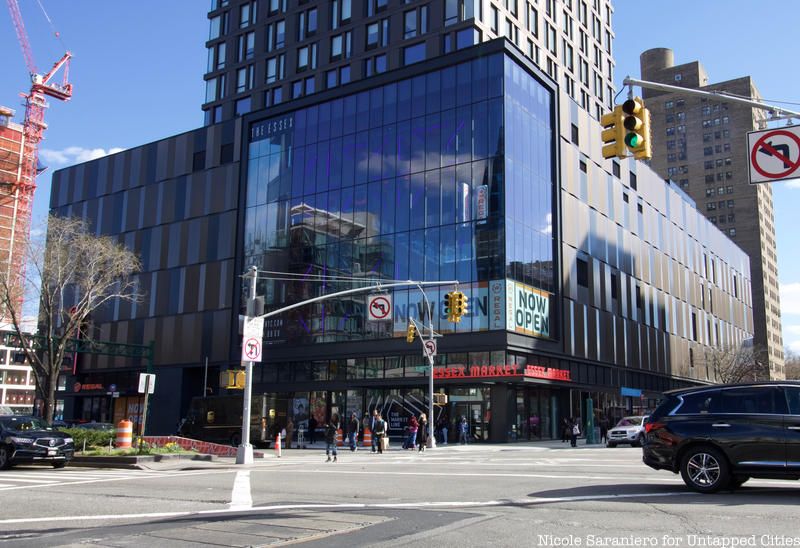
The new Essex Street Market spans 37,000 square-foot and has room for thirty nine individual vendors making it roughly three times the size of the old market. With all this new space the brand new market will include features and community assets not available in the original market such as a large mezzanine level of public seating, for up to 200 people, with floor to ceiling windows.
The increase in space will also allow existing market vendors to expand their offerings. With more room, vendors can add new stock and equipment. One way vendors are taking advantage of this is to add prepared food selections to their offering of provisions.
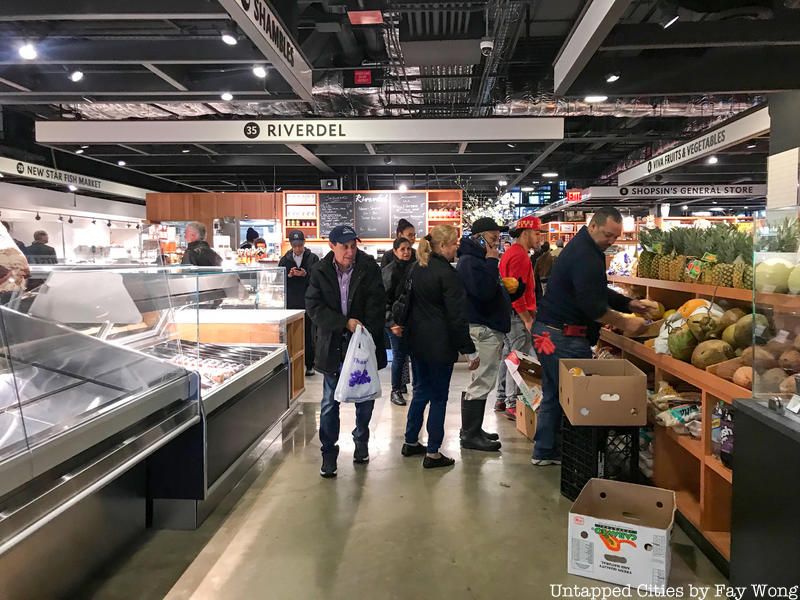
Photo by Fay Wong
Since there is much more space in the new market, there is room for even more vendors. In addition to all twenty-one of the original vendors making the move across the street, there are sixteen new vendors joining the mix. Some of the new vendors include Lower East Side Ice Cream Factory, Samesa, Don Ceviche, and Heros & Villains. There is even a vegan cheesemonger, Riverdel, opening in the new market, which will also sell specialty foods, fresh bread, and pastries.
Among the original vendors that are relocating there is the barber, who has been in business at the old market for over twenty years, Rainbo’s Fish Market, Puerto Rico Importing Company, Luna Brothers Fruit Plaza, and Davidovich Bakery Shop.
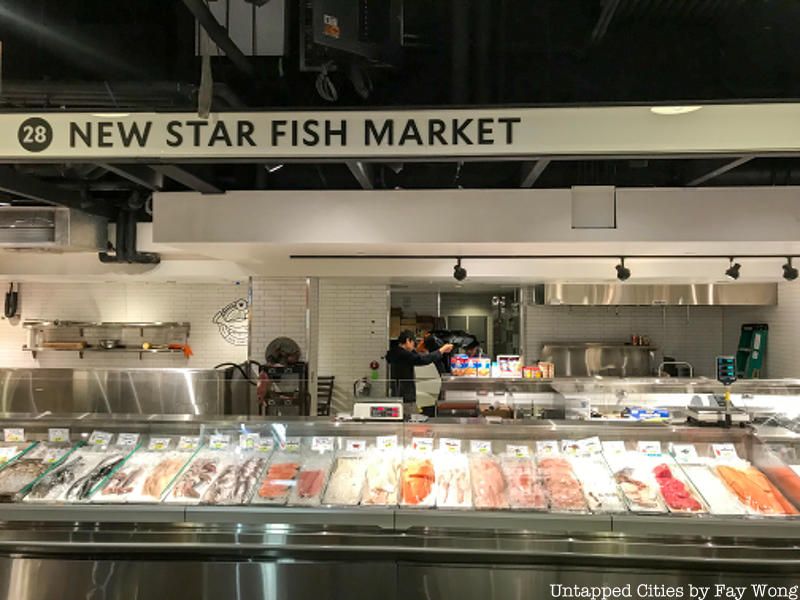
Photo by Fay Wong
The oldest vendor at Essex Street Market is New Star Fish Market, which opened in 1993. Founded by Jae Duk Suh with hopes of providing a better future for his family, the stall which specializes in fresh seafood remains family owned with his son Eric also involved now. He told the NYCEDC, “My happiest memories are of the daily interactions with my customers and forming long-lasting bonds, which I still have today. In the 1990s, AT&T filmed a commercial for the Super Bowl at New Star Fish Market.
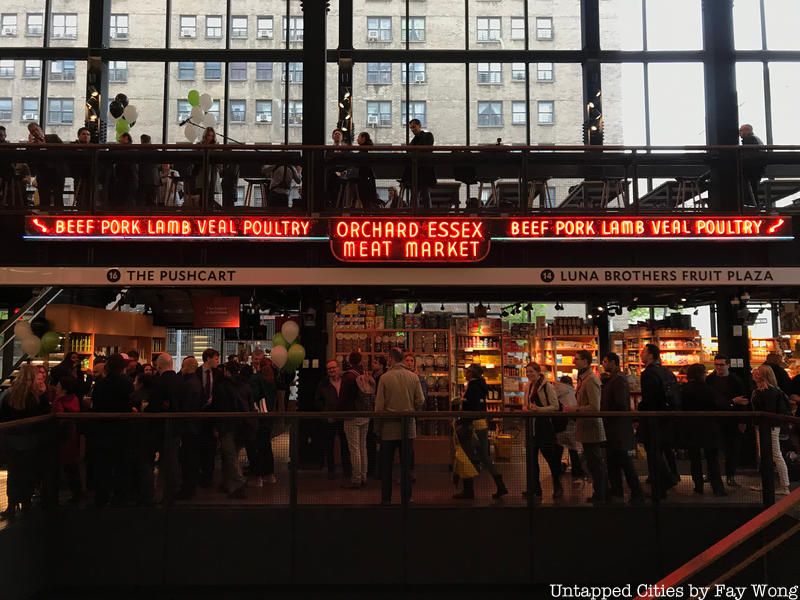
Photo by Fay Wong
The original Essex Street Market was made up of four separate buildings. Essex Building D actually stood on the site of the new market and a piece of that original building still survives in the form of a neon meat market sign. The sign which once hung in the original meat market during the 1940s now graces the side of the new market’s mezzanine level above the grand center staircase entrance. The neon was restored but the paint on the sign has been left as found.
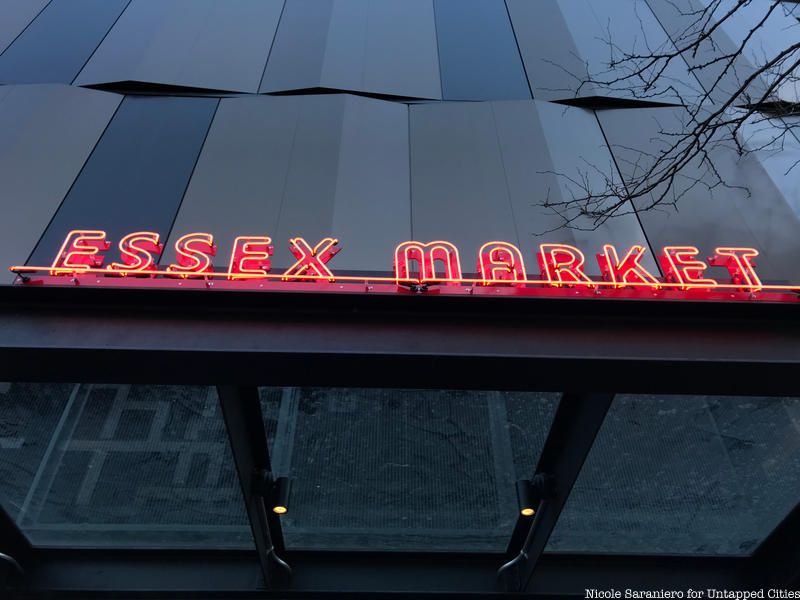
The typeface of the old neon sign was used to engineer a custom typeface which is used on signage throughout the rest of the market and outside on its marquee. The distinctive lettering is an homage to the market’s history.
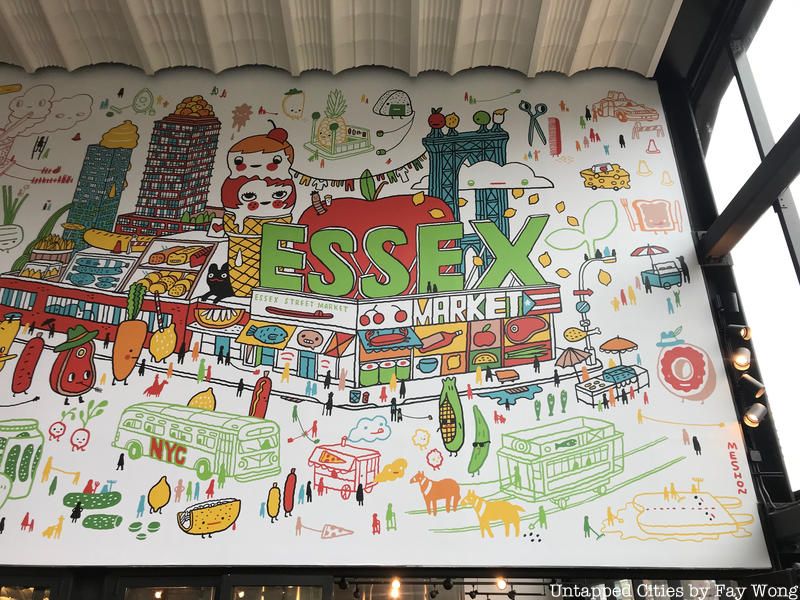
Photo by Fay Wong
The mural in the Essex Street Market above the demonstration kitchen is by Aaron Meshon, an artist and children’s book author based in Brooklyn. The work was chosen as part of an open call, with the winner chosen by curators at the Lower East Side Partnership, Community Board 3, Grand Street Settlement, Artist Alliance, Chinese-American Planning Council, and NYCEDC. The Essex Street Market posted on Instagram “We are thrilled with the clever take on our historic corner building and the detailed representations of all our vendors’ offerings.”
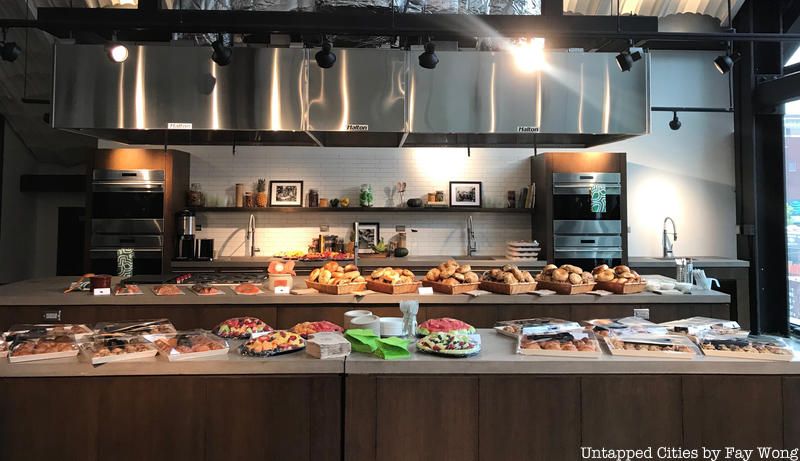
Photo by Fay Wong
The original Essex Street Market was all on one level, but the new one has two floors. Vendors occupy the entire ground level and above that there is a mezzanine with seating and a state-of-the-art demonstration kitchen. The two spaces can be connected by opening the large, glass French doors that separate them.
The kitchen, which has four ovens, two stoves four sinks and multiple moving work stations, will be used for cooking demonstrations and community events. This new space will give vendors an opportunity to show their goods in a new way and provide another channel through which the market can engage with the surrounding community.
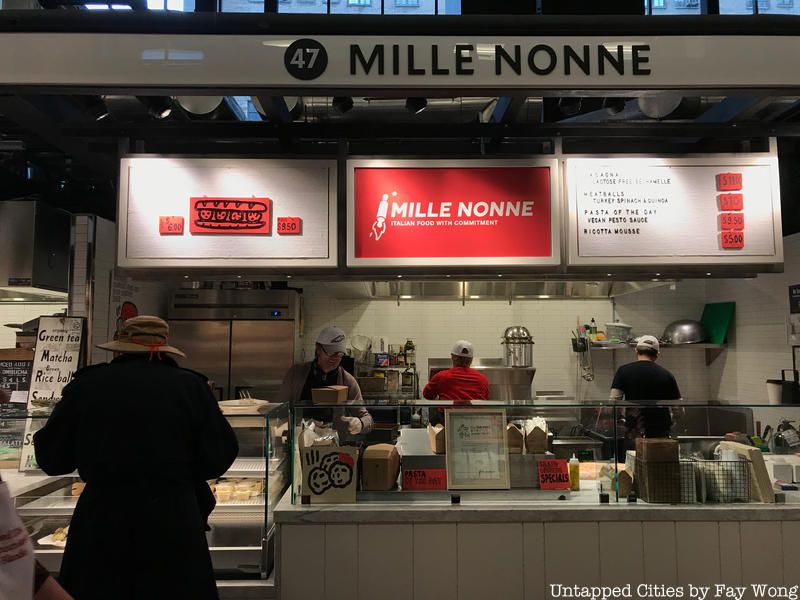
Photo by Fay Wong
The new Essex Street Market was designed by SHoP Architects and market architect Hugh A. Boyd. SHoP Architects have designed countless buildings in New York City such as the Barclays Center, 111 West 57th Street and the American Copper Buildings. Boyd has been the designing force behind massive markets in Philadelphia, Baltimore and other cities across the country.
In making the move across the street, each vendor received a brand new space. Boyd’s firm worked directly with the vendors to accommodate their needs and give their stalls character. SHoP and the NYCEDC set general design parameters for materials and colors, but each vendor was able to express personality in the design. You can see variations in color and materials as you walk through the market, and in addition to uniform signage which runs along the top of all the vendors, each stall has their own sign.
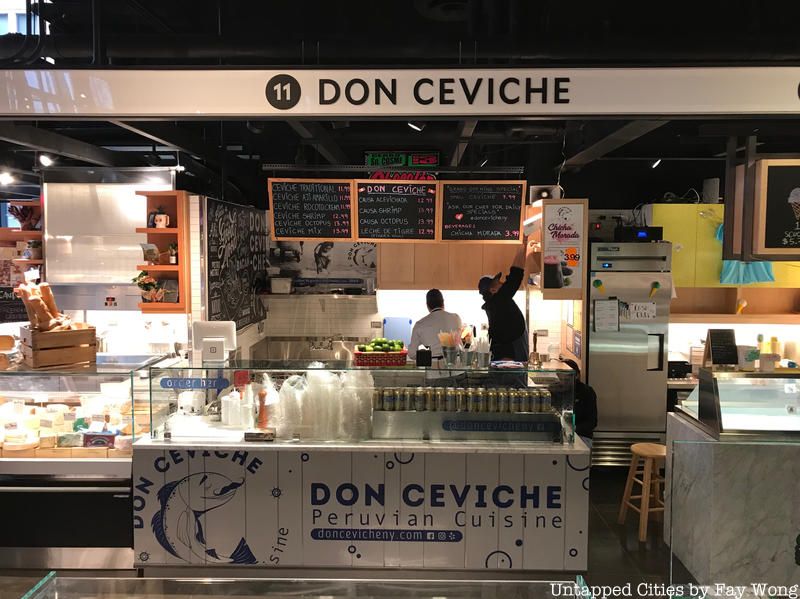
Photo by Fay Wong
Five vendors will be opening up their first brick & mortar stores at the new Essex Street Market: Mille Nonne, Don Ceviche, Zerza, Heros & Villians and Josephine’s Feast.
Another new addition to the market will be two full service restaurants. The first, Dhamaka will serve Indian street food and home-cooked cuisine, helmed by owner Roni Mazumdar who also operates the restaurant Rahi in Greenwich Village. The goal, he tells Eater, is to “demystify” Indian cuisine and show more regional dimension than the standard that gets served in the United States. Dhamaka is opening in about three months. The second full-service restaurant deal has not been inked yet.

When Mayor LaGuardia began his campaign to get pushcarts off the streets, he imagined an indoor system of marketplaces spread throughout the New York City. The network grew slowly over the decade and a half since his proposal by 1955 there were 10 public markets operating in New York City.
Today, there are only four public markets left of LaGuardia’s original ten. In addition to the Essex Street Market which is run by the New York City Economic Development Corporation, there is La Marqueta in Harlem, Moore Street Market in Brooklyn, and Arthur Avenue Market in the Bronx Essex Street Market was taken over by the NYCEDC in 1995 and was consolidated into one building with $1.5M in renovations. This is the first new market to open since 1955.
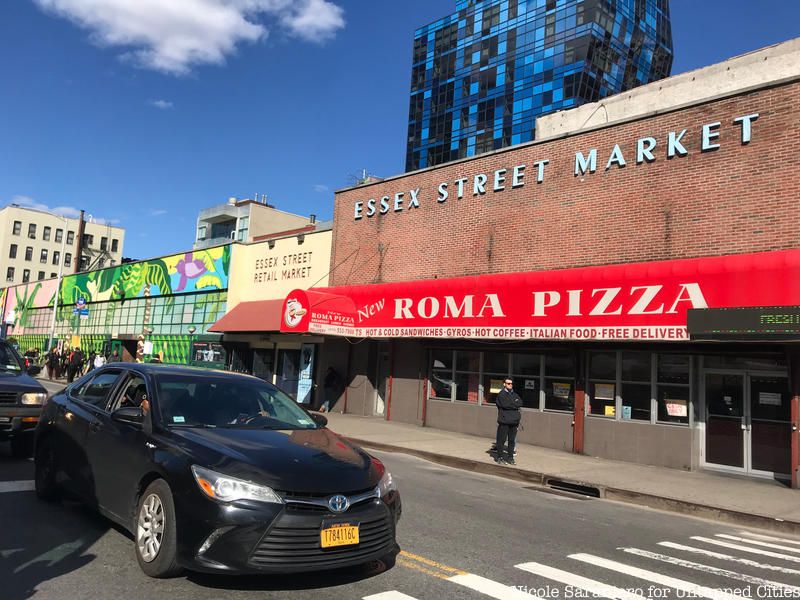
In the late 19th-century through the early 20th-century, New York City experienced a major influx of immigrants and many settled in the Lower East Side. As a means of making a living, many immigrants started pushcart businesses where they would sell goods on the streets. At one time there were below 14th Street and east of Broadway. Clusters of pushcarts gathered together to form outdoor markets. The street vendors provided an affordable place for neighbors to buy home goods and groceries.
During the 1930s, The Great Depression caused an intense rise in the number of pushcarts crowding the streets as jobless New Yorkers turn to peddling wares. The overcrowded streets posed many hazards since emergency vehicles couldn’t get through congestion and food safety was a concern. In 1934 Mayor Fiorello LaGuardia proposed a plan that would take pushcart vendors off the streets and into indoor markets with stalls. Essex Street Market became New York City’s fourth public market when it opened in 1940 with 475 stalls, atop land that had been cleared to make way for the new IND subway.
Next, check out The Top 10 Secrets of the Lower East Side and check out photos of the original Essex Street Market before it closed!
Subscribe to our newsletter